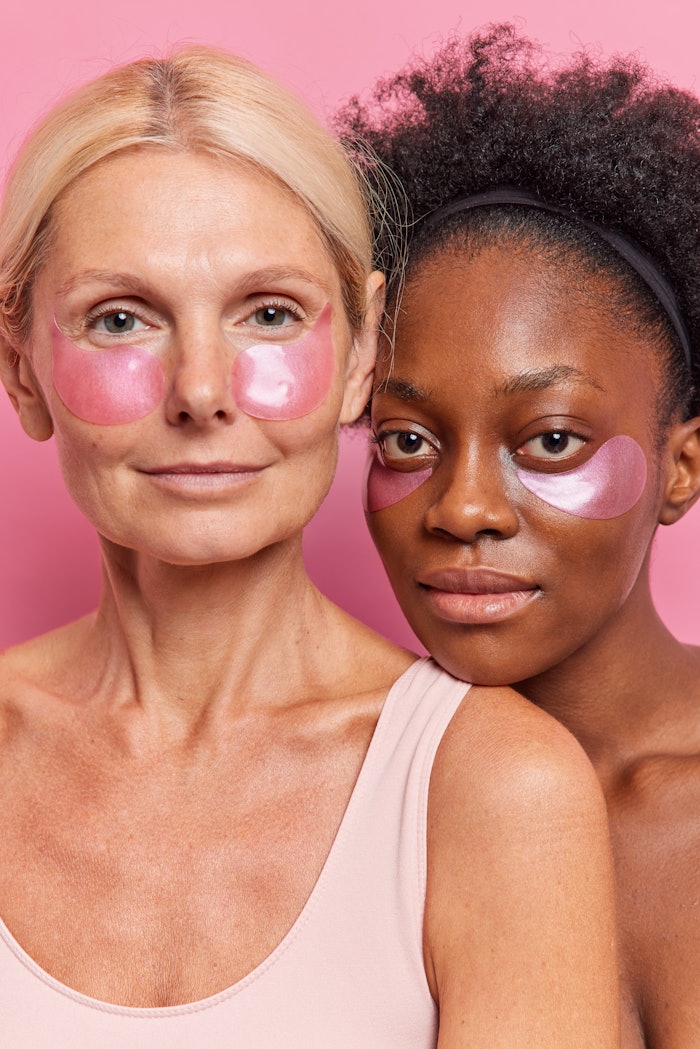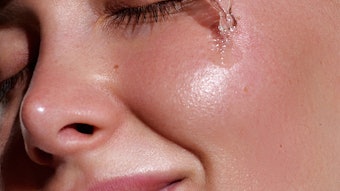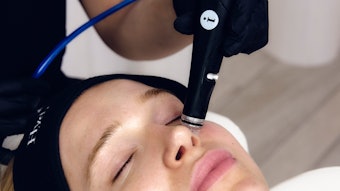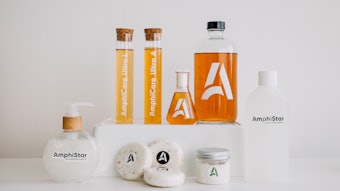
The industry’s evolution from conventional anti-aging to skin rejuvenation is well underway.
Log in to view the full article
The industry’s evolution from conventional anti-aging to skin rejuvenation is well underway.
To illustrate, in April 2024, Beiersdorf and Rubedo Life Science announced a partnership focused on the development of anti-aging technologies targeting cellular senescence.
At the time of the announcement, Gitta Neufang, Ph.D., corporate senior vice president global R&D, noted, “Following our ambition to be the leading innovator in skin care, we see enormous potential in the very dynamic research field of cellular senescence to develop superior solutions for skin rejuvenation.”
 In April 2024, Beiersdorf and Rubedo Life Science announced a partnership focused on the development of anti-aging technologies targeting cellular senescence.Rubedo Life Science
In April 2024, Beiersdorf and Rubedo Life Science announced a partnership focused on the development of anti-aging technologies targeting cellular senescence.Rubedo Life Science
According to the National Institute on Aging, "Senescent cells are unique in that they eventually stop multiplying but don't die off when they should. They instead remain and continue to release chemicals that can trigger inflammation."
The current scientific literaturea points to “growing evidence that cellular senescence may be an essential mechanism that drives organismal aging,” including in the skin, leading to common issues such as “wrinkling, sagging, dryness or age spots.”
To counteract these issues, Rubedo has developed topical compounds that deliver senolytic (senescence-reducing) and anti-inflammatory benefits.
“[T]his partnership may revolutionize the landscape of skin care products,” said Rubedo CEO Marco Quarta, “offering consumers new solutions that treat cellular aging for healthy and youthful-looking skin.”
Senescent Technologies Already on the Market
While Beiersdorf-Rubedo collaborative technologies are forthcoming, a number of suppliers have already launched senescence-targeting ingredients in recent years.
Senescent Tech for Looking 6 Years Younger
For instance, DSM-Firmenich’s Eterwell Youth (INCI: Epilobium fleischeri leaf/stem extract) is a senolytic skin care technology that reportedly reduces the number of excess senescent cells in the epidermis and dermis (per in vitro and ex-vivo tests), thereby diminishing senescent markers such as p16 and p21 (as illustrated ex vivo, per the company).
 DSM-Firmenich's Eterwell Youth won the Best Active Ingredient Award in the skin care category at the 2024 in-cosmetics Global event in Paris.DSM-Firmenich
DSM-Firmenich's Eterwell Youth won the Best Active Ingredient Award in the skin care category at the 2024 in-cosmetics Global event in Paris.DSM-Firmenich
Furthermore, senescent cells are replaced with high-performing cells that boost collagen by 44% (ex vivo with 1% Eterwell Youth).
According to DSM-Firmenich, 3% of Eterwell Youth applied for 2 weeks boosts skin smoothness by 24%, “corresponding to a skin physiological age looking 2 years younger and even 6 years younger after 3 months.”
The same concentration of the ingredient also cuts crow’s feet wrinkle volume by 17% and depth by 11% within 3 months.
DSM-Firmenich adds that Eterwell Youth has a synergistic effect when formulated in conjunction with technologies such as TGF- β and retinol.
The ingredient is COSMOS approved, Natrue organic and Fair for Life fair trade certified. The extract is sourced from rare Alpine willowherb that is organically cultivated in a Swiss ancient glacier moraine.
Boosting Senescent Cell Death
Elsewhere, Provital’s Altheostem is derived from lab-grown Althaea rosea (hollyhock) stem cells and reduces the number of senescent skin cells by 44% (in vitro) by inducing apoptosis (cell death). Furthermore, the technology promotes the expression of genes involved in the extracellular matrix (ECM) remodeling of senescent human dermal fibroblasts (HDF).
Counteracting Immunoevasion
Silab’s Senevisium, inspired by the Ginkgo biloba tree, circumvents the “immunoevasion” strategies of senescent fibroblasts and reactivates their natural elimination by the immune system. When treated with Senevisium, the skin reportedly recovers its density and elasticity for an anti-wrinkle and radiance-boosting action.
Pomegranate Senescent Cell Fighter
Meanwhile, Active Concepts’ AC PomeaShield (INCI: water (aqua) (and) Punica granatum fruit extract (and) Lactobacillus ferment) is a pomegranate-derived skin care ingredient that stimulates elastin synthesis in fibroblasts while promoting a smooth and firm complexion.
AC PomeaShield is formulated to target and neutralize reactive oxygen species (ROS), combat cellular aging and address senescent cells. Its antioxidant properties in effect act as a shield, safeguarding the skin from oxidative stress, per the company.
NAD+ Booster
Mibelle Biochemistry’s RejuveNAD technology naturally stimulates the endogenous regeneration of NAD+ by activating the enzyme NAMPT, thereby making the skin appear as much as eight years younger.
 By boosting the “longevity molecule,” NAD+, RejuveNAD is able to optimize cellular processes to simultaneously address “at least” five of the 12 hallmarks of aging, including mitochondrial dysfunction, cellular senescence, loss of proteostasis, epigenetic alteration and genomic instability.Mibelle Biochemistry
By boosting the “longevity molecule,” NAD+, RejuveNAD is able to optimize cellular processes to simultaneously address “at least” five of the 12 hallmarks of aging, including mitochondrial dysfunction, cellular senescence, loss of proteostasis, epigenetic alteration and genomic instability.Mibelle Biochemistry
By boosting the “longevity molecule,” NAD+, RejuveNAD is able to optimize cellular processes to simultaneously address “at least” five of the 12 hallmarks of aging, including mitochondrial dysfunction, cellular senescence, loss of proteostasis, epigenetic alteration and genomic instability.
At in-cosmetics Global in Paris, the company noted that RejuveNAD is already finding its way into product innovation, a sign that the technology is being fast-tracked by R&D teams, and is set to debut in a product aimed at treating the decolletage area.
As this array of launches and investments shows, the industry’s focus on senescent cells is just beginning.
in-cosmetics 2024 Highlights
In recent months, Global Cosmetic Industry magazine has been previewing technologies that made their debut at the 2024 in-cosmetics Global event in Paris. Now, following the show, we present here select highlights from the exhibition.
Expect to see additional technologies in subsequent issues, including a roundup of hair-centric tech in the September 2024 edition of this magazine.
For now, here are some of the most notable highlights as viewed by our editors.
A New Beauty Film
 SilaFilm Pureness features Acnesium for anti-seborrhea and hydrating effects on oily, acne-prone skin.Silab
SilaFilm Pureness features Acnesium for anti-seborrhea and hydrating effects on oily, acne-prone skin.Silab
The films can be activated in contact with water, which releases the embedded active molecules that then penetrate deep into the skin.
SilaFilm allows Silab to deliver new beauty technology experiences beyond its standard liquids and preservative-free powders.
This new film format features high bioavailability and skin tolerance, allowing films to be applied daily for as long as 10 or even 20 minutes at a time.
 SilaFilm Radiance comprises Silab’s Oxygeskin and p-Refinyl to boost hydration and smoothness in mature skin for enhanced radiance.Silab
SilaFilm Radiance comprises Silab’s Oxygeskin and p-Refinyl to boost hydration and smoothness in mature skin for enhanced radiance.Silab
SilaFilm Pureness, meanwhile, features Acnesium for anti-seborrhea and hydrating effects on oily, acne-prone skin.
Cross-generational Beauty Innovation
In the age of Generation Alpha/Sephora kids, the beauty industry has become even more hyper-focused on serving consumers at every life stage.
During in-cosmetics Global 2024 in Paris, Vantage Personal Care noted that, “Understanding and adapting to diverse generational preferences in beauty and personal care is essential for brands seeking to maintain relevance and capture market share.”
The firm added, “Generational groups exhibit distinct preferences shaped by cultural influences, technological advancements and societal shifts.”
To illustrate the innovation opportunities, the company presented a range of cross-generational formulation concepts. Across generations, two themes remained steady:
- formulations designed for sensitive skin and
- formulations optimized to prevent and/or minimize the appearance of aging.
 During in-cosmetics Global 2024 in Paris, Vantage Personal Care noted that, “Understanding and adapting to diverse generational preferences in beauty and personal care is essential for brands seeking to maintain relevance and capture market share.” To illustrate the innovation opportunities, the company presented a range of cross-generational formulation concepts.Vantage Personal Care
During in-cosmetics Global 2024 in Paris, Vantage Personal Care noted that, “Understanding and adapting to diverse generational preferences in beauty and personal care is essential for brands seeking to maintain relevance and capture market share.” To illustrate the innovation opportunities, the company presented a range of cross-generational formulation concepts.Vantage Personal Care
Meanwhile, a Bubble Pop Lip Balm that smooths and nourishes the lips featured oleic acid-rich and stearic acid-rich Lipobutter Refined Shea, DW Jojoba Colorless and Lipovol C-76, a nourishing coconut oil.
For Gen Z, Vantage created the water-based Gelly Cleanser, which featured Curazelic 44, a solubilized azelaic acid, gentle BP-Willow Bark Extract, and soothing Centella asiatica extract. The gel lathered into a bubbly foam and gently addresses hyperpigmentation without stripping or drying the skin.
The Azelaic Acid + BHA Spot Treatment, meanwhile, also featured Curazelic 44, solubilized salicylic acid (Curcylic 40) and soothing Liponate Jojoba NatFilm
For millennials, Vantage developed a full-body, sensitive-skin-friendly Hydra-Repairing Serum Stick featuring three molecular weights of hyaluronic acid (BP-Triluronic Acid A) that act at different levels of the skin and BP Botanidew NMF, which supports the skin’s natural moisturizing factors.
A Protective Under Eye Complex, meanwhile, was a lightweight eye serum that featured Biosignal Lipid 10 and BP-Triluronic Acid for hydration and revitalization, as well as DC Instalift Goji and Adaptogen Fermbiotic S to tighten and plump the skin, thereby diminishing the appearance of fine lines and wrinkles. The formulation also included Coolact 10 for a cooling and depuffing effect, as well as oxidative stress defense from Liposhield HEV Melanin.
For Gen X, an Overnight Recovery Cream featured Lipobead Pink Princess and Adaptogen Fermbiotic S for firming and lifting, as well as conditioning Liponate Jojoba 20 and antioxidant Strataphix Poly-PF.
The gentle Precious Oil Cleansing Balm, meanwhile, was formulated to wash away makeup with conditioning Absolute OC Resilience and hydrating BP-Triluronic Acid A.
Finally, for baby boomers, Vantage developed a Hydra-Trio Moisture Replenishing Cream with moisturizing and film-forming Hylasome EG10, skin-mimetic and moisturizing Biosignal Lipid 10, and hydrating emollient Liponate Jojoba 20.
Finally, the boomer-targeted Hand Savior Ointment again featured Vantage’s Liponate Jojoba 20, as well as skin-barrier-supporting Biosignal Lipid 10 and antioxidant Strataphix, which reportedly reduced the appearance of UV-induced age spots and textures.
A Snail-inspired, Needle-free Botox Alternative
Activen’s new XEP-018 muscle relaxant miniprotein is reportedly naturally present in the venom of the sea snail Conus consors, which is found in the Pacific Ocean. In the wild, this mini protein is used to immobilize the snail’s prey.
Activen has proposed XEP-018 as a cosmetic muscle relaxant to reduce the appearance of wrinkles. Unlike traditional botulinum toxin injections, however, the company claims the miniprotein easily penetrates the skin, negating the need for needles.
Restoring the Skin’s Cell Elasticity
LipoTrue’s Frag-Brillin remastered comprises a biomimetic fibrillin-1 fragment derived from plants grown via vertical farming. The ingredient reportedly stimulates fibrillin microfibrils, which stretch and recoil, thereby triggering the skin’s TGF-β repair response and fibroblast-to-myofibroblast transition.
They are therefore critical for supporting the skin’s flexibility, structural integrity and remodeling capabilities. Because these microfibrils decline with age, the skin typically loses its elastic resilience over time.
In formulations, Frag-Brillin remastered reportedly boosts elastic fiber formation and rebuilds elastic resilience. It also enhances cell elasticity and skin remodeling to “instantly” enhance skin firmness and elasticity in both the face and body and thereby immediately smooth the appearance of wrinkles.
According to LipoTrue, 82% of volunteers using the ingredient showed firmer skin within 56 days, while facial elasticity reportedly grew as much as 17% within 28 days. Within just 1 hour of use, users experienced as much as a 17% boost in the firmness of the face, a nearly 7% decline in cheek roughness and nearly 14% drop in crow’s feet wrinkle depth.
Antidepressant-mimicking Beauty
 Hallstar Beauty’s Bliss Oléoactif (INCI: Helianthus annuus (sunflower) seed oil (and) Tilia cordata wood extract (and) polyglyceryl-3 diisostearate) reportedly took inspiration from antidepressants and light therapy to address stress-induced skin issues.TanyaJoy at Adobe Stock
Hallstar Beauty’s Bliss Oléoactif (INCI: Helianthus annuus (sunflower) seed oil (and) Tilia cordata wood extract (and) polyglyceryl-3 diisostearate) reportedly took inspiration from antidepressants and light therapy to address stress-induced skin issues.TanyaJoy at Adobe Stock
The technology inhibits the ability of monoamine oxidase A (MAO-A) to eliminate neurotransmitters such as serotonin from the body.
By boosting serotonin production, Hallstar Beauty argues that Bliss Oléoactif “constrain[s] stress’ negative impact on skin.”
The result: diminished appearance of stress lines and wrinkles, as well as reduced discomfort and redness for a glowing complexion.
A Lifestyle-proof Anti-ager
 In formulations, Zenerity reportedly boosts moisturization, reduces skin redness by more than 15% within 30 minutes and diminishes the appearance of wrinkles.Lipotec
In formulations, Zenerity reportedly boosts moisturization, reduces skin redness by more than 15% within 30 minutes and diminishes the appearance of wrinkles.Lipotec
In formulations, Zenerity reportedly boosts moisturization, reduces skin redness by more than 15% within 30 minutes and diminishes the appearance of wrinkles.
The China-compliant, halal, COSMOS- and Ecocert-compliant, and ISO 16128-certified ingredient is appropriate for even sensitive skin for a calmed, soothed, luminous and more youthful-looking skin.
A Wakeup Call for the Eyes
Gattefossé’s new Eyeglorious is a lipophilic active that addresses signs of fatigue in the eye area.
 Gattefossé’s new Eyeglorious is a lipophillic active that addresses signs of fatigue in the eye area.Pormezz at Adobe Stock
Gattefossé’s new Eyeglorious is a lipophillic active that addresses signs of fatigue in the eye area.Pormezz at Adobe Stock
These acids reportedly boost the skin’s microcirculation by reducing inflammation-induced vascular permeability and reinforcing the endothelial barrier function.
They also present potential in the degradation of the red pigment of dark circles.
Tested on a model of human dermal microvascular endothelial cells stressed with TNF-α, the active purportedly lead to a significant reduction in vascular permeability, which is responsible for the appearance of edema and dark circles.
Furthermore, Eyeglorius promoted the degradation of hemoglobin and prevented oxidation, which are key contributors to under-eye hyperpigmentation.
Two double-blind clinical studies reportedly confirmed Eyeglorius’ efficiency in reducing signs of fatigue.
Tested against a placebo, it achieved a significant reduction of eye bag volume and generated a lighter appearance and smaller surface for dark circles, per the supplier.
Niacinamide-based Multifunctional Preservation
Sharon Personal Care’s new vitamin-based multifunctional preservation line, AquaVita, is based on niacinamide (vitamin B3). The mild sustainable antimicrobial preservation solution both protects formulations and contributes to skin health.
AquaVita features enhanced hydrophilicity, which boosts its effectiveness against microorganisms. Rather than solely impacting microorganisms’ outer layer, it disrupts their reproductive process, per Sharon Personal Care, making it more effective at preventing their growth. The technology has reportedly been dermatologically tested for sensitive skin, is microbiome friendly and shows excellent antioxidant properties.
Currently, two ingredients have joined the line, including: Sharon AquaVita 90 (INCI: niacinamide, glyceryl caprylate, decylene glycol) and Sharon AquaVita 95 (INCI: niacinamide, polylysine).
Naama Eylon, CEO of Sharon Personal Care, commented, “AquaVita goes beyond preservation and is truly multifunctional. It combines antimicrobial efficacy and clinically proven skin care benefits, such as reduced pigmentation, skin brightening and skin barrier strengthening.”
Mood-boosting Tech with Microbial Defense
Symrise’s Flowerconcentrole functional olfactive flower extracts deliver a well-being boost, according to the company.
 Symrise’s Flowerconcentrole functional olfactive flower extracts deliver a well-being boost, according to the company.Symrise
Symrise’s Flowerconcentrole functional olfactive flower extracts deliver a well-being boost, according to the company.Symrise
Skin care brands can reportedly use the flower extracts to deliver holistic care with a wellness sensory angle.
The natural technologies, which are transparent to slightly opalescent liquids, are reportedly easy to use in any emulsion or water-based formula.
They can also mask the smell of beauty formula bases and provide antimicrobial properties.
The range's functional and biodegradable plant extracts, which are 100% natural in line with ISO 16128, are sustainably sourced from Madagascar, France and Bulgaria, per Symrise.
“We feel delighted to launch this new functional flower extract range, using our neuroscience capabilities to link olfactive skin care with mood enhancement,” said Marcus Höflich, global category director botanicals at Symrise. “People have associated botanicals with emotions for a long time. Flowerconcentrole marks the next step in our 70-year journey as an innovator in this field, helping skin care brands release the full potential of flower extracts while caring for the environment.”
Low-irritation Retinoid for Photoaged Skin
Grant Industries' Granactive Retinoid Pro+ comprises hydroxypinacolone retinoate (HPR) encapsulated in cyclodextrin to boost skin bioavailability, protect from degradation and minimize potential irritation.
In this way the technology is able to deliver anti-aging efficacy with antioxidant benefits to photoaged skin. Granactive Retinoid Pro+ can therefore serve as a conventional retinol alternative in both facial and body care.
Skin Longevity Booster
 Greentech’s Timelys active features schisandrin extracted from Schisandra chinensis (five-flavor berry) sourced in Liaoning Province in China.Ivanna at Adobe Stock
Greentech’s Timelys active features schisandrin extracted from Schisandra chinensis (five-flavor berry) sourced in Liaoning Province in China.Ivanna at Adobe Stock
Timelys reportedly increases the expression of LC3 proteins and LAMP2 genes, which regulate autophagy. The ingredient also cuts ROS by 16% and boosts antioxidant enzymes.
Furthermore, Timelys reportedly decreases PGE2 (responsible for collagen production inhibition, among other issues) by 87% and inflammatory IL6 by 66%. To address dysbiosis, the ingredient purportedly reinforces the skin barrier and enhances skin hydration, radiance and microcirculation.
Taken together, Timelys’ multifunctional benefits are designed to grow the skin’s healthspan and prevent future damage. Suggested applications include well-aging, longevity-focused formulations, preventive skin care and more.
Shine-reducing Balancing Technology
BASF Personal Care’s Epispot addresses the root causes of imbalances affecting lipids, microbiota and the skin’s natural defense system to reduce skin shine, improve the appearance of facial pores and promote a healthy complexion for consumers of any age or background.
The ingredient is applicable in face serums, cleansers and makeup formulations.
A randomized, split-face study with 34 female volunteers that applied an emulsion with 0.2% Epispot and a placebo emulsion twice daily for eight weeks reportedly found that, after 56 days, excess skin greasiness was reduced by 37% compared with the placebo.
At the same time, 88% perceived an immediate matte effect from Epispot, which lasted all day for 78% of the women, per BASF.
All participants stated in a questionnaire that their skin texture was improved, while 90% reported that their skin felt smoother and 88% said that their pores appeared to be tightened.
Furthermore, 90% of study participants said their skin appeared healthier at the end of the application period.
The effect of Epispot on skin oiliness has been tested using an ex vivo 3D model of the pilosebaceous unit, including the hair follicle, hair shaft and sebaceous gland. This new model makes the 3D skin structure transparent to better visualize skin architecture, per BASF. Combined with advanced microscopic techniques, it allows for an in situ evaluation of the effect of Epispot on skin oiliness at the source.
Epispot comprises an extract of organic Epilobium angustifolium, also known as fireweed or phoenix flower, manually harvested from six sites in rotation in France in compliance with AFC (in English, the French Association of Professional Wild Plants Pickers) guidelines around respectful harvesting of wild plants.
The sourcing strategy is in line with BASF’s larger sustainability strategies.
Silk-derived Pollution Defense & Pore Reducer
Givaudan Active Beauty's new biomimetic Silk-iCare vegan silk protein for skin protection and repair offers unique film-forming properties.
The technology was developed via white biotechnology as part of a process of optimizing a sequence of silk proteins produced through fermentation.
 Givaudan Active Beauty's new biomimetic Silk-iCare vegan silk protein for skin protection and repair offers unique film-forming properties.Givaudan
Givaudan Active Beauty's new biomimetic Silk-iCare vegan silk protein for skin protection and repair offers unique film-forming properties.Givaudan
The technology's hydrogel structure is derived from natural silk and offers thixotropic characteristics, which means it changes “viscosity when loaded by stress by becoming less viscous,” per Science Direct.
Notably, when at rest these materials become more solid than when compressed.
The result is a smoother application and a breathable, non-sticky finish, per Givaudan.
Silk-iCare's film-forming properties offer anti-pollution defense by removing more than 96% of pollution particles.
In addition, the ingredient reportedly has been shown to offer a 7-fold reduction in pore size in as little as 15 minutes, as shown in clinical studies.
Finally, Silk-iCare's skin repair qualities can, over time, trigger a 2-fold reduction in inflammatory breakouts, thereby perfecting skin, per Givaudan.
Resolving TGF-β’s Absorption
Activen’s XEP-716 growth factor miniprotein reportedly offers tissue regeneration and wound healing benefits in restorative beauty formulations. The miniprotein’s small size and 3D folded structure reportedly allows the technology to penetrate deeply into the skin. The ingredient resolves the conventional absorption issues faced by TGF-β growth factors, thereby delivering anti-aging activity consumers desire.
Volumizing Anti-aging
Biocogent, LLC’s Volpura EPO is derived from Echinacea purpurea and delivers anti-aging benefits by supporting the skin’s natural plumping processes through the stimulation of adipocytes (fat cells) and upregulation of fat production by up to five times. This is accomplished via the activation of the adipogenesis master regulator, PPAR-γ.
The resulting plumping and contouring effects minimize the appearance of wrinkles and sagging. In doing so, the technology can deliver fuller, more youthful-looking skin, per the company.
Volpura EPO can be incorporated into hot pour and hot cast products such as lipsticks, lip balms and lip glosses, as well as facial and body products. It reportedly offers proven efficacy and stability at elevated temperatures up to 85°C.
Smart Peptide Targeting Sebum and Pore Size
LipoTrue’s SP[AI]3 smart peptide was screened in silico with an AI system to identify a material with ideal applications for beauty. The ingredient reportedly improves the appearance of blemishes and imperfections in acne-prone skin by addressing sebum synthesis, pore size and obstruction, and inflammation.
SP[AI]3 reportedly reduces pimples by 19% within 14 days, cuts pore size by 8% in 28 days and results in as much as 39% less sebum within 1 week.
Rose-based Anti-aging
Robertet’s new AQ3Rose, developed with Aethera Biotech’s CROP-G (Controlled Release of Optimized Plants) platform, is a standardized phytocomplex of Rosa chinensis from meristematic cell cultures titrated in polysaccharides and phytocollagen.
In formulations, the technology delivers deep moisturization, anti-wrinkle care, a collagen production boost for enhanced skin elasticity, and lash volumizing and lengthening.
Because the material is produced on the CROP platform, the GMO material is free of environmental contaminants and solvent residues. It is certified Ecocert Greenlife and conforms to the COSMOS standard.
Natural Film Former with Lifting, Water-resistant Properties
Beauté by Roquette's new ST 730 water-resistant film former (INCI: hydroxypropyl starch) reportedly imparts a lifting/tightening effect in applications such as eye care and face care products.
The technology has stronger water resistance compared to synthetic film formers, per the supplier, thereby supporting long-lasting and water-resistant color cosmetic claims.
In fact, use of Beauté by Roquette's ST 730 at 5% in one study reportedly showed higher water resistance compared to the same amount of common equivalents such as pullulan and polyvinylpyrrolidone (PVP), at the same concentration.
According to a recent Mintel analysis, long-lasting makeup delivers buy-in from both casual and more moderate users of color cosmetics.
ST 730 can also reduce the appearance of wrinkles via its tightening effect.
According to the results of one in vivo study featuring 40 volunteers applying 4% ST 730, 82% of the participants said that fine lines and wrinkles were diminished.
ST 730's pea starch has minimal impact on water resources, climate change and land use, per the company, because Beauté by Roquette uses nearly every component of the yellow pea grain source.
Bio-prospected Beauty
Apoena Biotech recently held its second bioprospecting expedition for sustainable biological actives, this time in the Tapajós National Forest of Pará in Brazil's Amazon; this expedition follows the group's inaugural harvesting of the "blue Amazon" in waters off the coast of Brazil.
 “The Amazon Forest's soil, though lacking in nutrients, boasts an extensive array of microbiological diversity," said Paula Segura, leader of the bioprospecting laboratory at Apoena Biotech. "This diversity is essential for recycling organic matter and fostering the growth of diverse life forms. It achieves this through processes such as the production of plant hormones, the availability of nutrients, and even the inhibition of plant pathogens."Apoena
“The Amazon Forest's soil, though lacking in nutrients, boasts an extensive array of microbiological diversity," said Paula Segura, leader of the bioprospecting laboratory at Apoena Biotech. "This diversity is essential for recycling organic matter and fostering the growth of diverse life forms. It achieves this through processes such as the production of plant hormones, the availability of nutrients, and even the inhibition of plant pathogens."Apoena
Key biological actives from this bioprospecting mission are expected to be available to the market beginning in September 2025.
Permission for the mission came from SISBIO (Biodiversity Authorization and Information System) ICMBio Santarém (Instituto Chico Mendes de Conservação da Biodiversidade) and leaders of traditional Amazon communities to align information to be shared with the Tapajós Flora Federation.
The researchers manually collected tiny samples (less than 5 g) from roots, stems, leaves, fruits, litter and soil for reproduction via biotech, thereby preserving biological resources while accessing novel natural actives.
“The Amazon Forest's soil, though lacking in nutrients, boasts an extensive array of microbiological diversity,” said Paula Segura, leader of the bioprospecting laboratory at Apoena Biotech. “This diversity is essential for recycling organic matter and fostering the growth of diverse life forms. It achieves this through processes such as the production of plant hormones, the availability of nutrients, and even the inhibition of plant pathogens. The average annual temperatures in the Amazon Forest usually range between 22°C and 28°C, and the relative humidity is also high. This scenario makes the region conducive to developing a vast diversity of microbial species.”
Upcycled Ingredient Technologies Become Ubiquitous
There was a time when upcycled concepts—though a legacy process throughout the history of beauty—became a unique differentiator. Judging from the latest launches from in-cosmetics Global in Paris, upcycling is now a widespread claim.
 Carbonwave’s SeaBalance 2000, an upcycled emulsifier made from seaweed, recently made a high-profile debut in KMS Hair’s new ConsciousStyle Beach Style Crème.KMS Hair
Carbonwave’s SeaBalance 2000, an upcycled emulsifier made from seaweed, recently made a high-profile debut in KMS Hair’s new ConsciousStyle Beach Style Crème.KMS Hair
SeaBalance 2000 is an emulsifier upcycled from sargassum seaweed, a nuisance ocean botanical that has made headlines for menacing beach communities with muck and unpleasant odors. Carbonwave partners with local communities in Mexico to collect the seaweed. That material is then processed to produce the vegan ingredient technology.
The emulsifier can reportedly be used to create fluid, low viscosity oil-in-water emulsions—either via cold process or in a traditional hot process. On skin, it leaves a soft and silky feeling, per Carbonwave.
Back on land, Herbarom now offers apple blossom water derived from Rhone Valley blooms that are typically “thinned” from trees to encourage larger yields of fruit. The water is available with potassium sorbate, sodium benzoate and citric acid, or benzyl alcohol, dehydroacetic acid and water. The clear, colorless liquid has a light and pleasant odor and is rich in polyphenols that offer antioxidant benefits.
The company also offers an apricot blossom water that is similarly produced and which promises similar benefits to formulations.
Herbarom’s chestnut hydro glycerin extract, meanwhile, is derived from the pericarps of chestnuts sourced from Ardeche, France. The preservative-free material offers antioxidant and anti-aging benefits, per the company.
Forestry also offers benefits. For instance, Innomost’s Betuinno. Betulin is a material upcycled from birch bark that is intended to replace white pigments such as titanium dioxide in beauty and personal care products.
 The vegan, "largely anti-allergic" technology also has antioxidant and anti-inflammatory properties for skin care. In applications, Betuinno. Betulin can reportedly help the skin to heal and regenerate, while delivering moisturizing effects.Innomost
The vegan, "largely anti-allergic" technology also has antioxidant and anti-inflammatory properties for skin care. In applications, Betuinno. Betulin can reportedly help the skin to heal and regenerate, while delivering moisturizing effects.Innomost
The vegan, “largely anti-allergic” technology also has antioxidant and anti-inflammatory properties for skin care. In applications, Betuinno. Betulin can reportedly help the skin to heal and regenerate, while delivering moisturizing effects.
Lumene skin care is already an Innomost client.
“The cooperation with Innomost is highly valuable, offering locally sourced upcycled ingredients, as an example, we were able to formulate birch upcycled ingredients and phased out microplastic scrubbing particles with Barkinno Birch Bark Powder,” said Alain Mavon, Ph.D., VP R&D and sustainability, Lumene. “In addition, as Innomost is continuously innovating, together we will continue exploring usage of existing or test new birch derived ingredients to increase the usage of upcycled and circular ingredients in our formulations. By increasing the usage of birch derived ingredients in our portfolio, Innomost is key partner to ensure we are delivering on our strategy and vision of Leading in Circular Beauty.”
Betulin’s development has been aided by €1.4 million in additional funding from Innomost’s existing investors, Metsä Spring and Innovestor.
“We are delighted to bring this new product to the market, as consumer needs and new regulations demand that beauty products are truly sustainable and safe, while providing transparency to the end-users of what the products contain,” said Sami Selkälä, CEO and founder of Innomost. “The Betuinno. Betulin white pigment can be utilized in different use cases, which enables Innomost to enter new industries–our products are already loved in the cosmetics industry, so we are excited to bring wood-based solutions to other players, too.”
 Eco-Shell presented its ground walnut shell materials for beauty at in-cosmetics Global.Eco-Shell
Eco-Shell presented its ground walnut shell materials for beauty at in-cosmetics Global.Eco-Shell
Bio-Powder also offers a range of agriculturally derived upcycled materials, including ground olive stones, which are an effective sustainable alternative to microplastics, per the company. The ground olive stones reportedly have high stability and hardness, making them particularly effective in exfoliants or heavy-duty cleaners, hand cleaners, and hand washing pastes. In fact, abrasion may be achievable with olive stones using as much as 5% less material compared to other natural options.
Bio-Powder’s argan shell flour, meanwhile, functions as a rheology modifier and lends its characteristic color to creamy formulations. Certain grain sizes can be used as exfoliants and lack water solubility, ideal for waterproofing agents. Its dispersibility reportedly makes the material ideal for makeup products in which it creates a non-allergenic shimmering effect. Finally, the flour’s high vitamin E content provides skin-friendly antioxidant properties.
Sensory-forward Innovation
Driven by the need for more engaging, emotionally fulfilling product experiences, a wide range of suppliers put sensory concepts front-and-center at in-cosmetics Global.
 IFF's Crackling Body Mousse is a whipped, airy formulation with a light touch and effervescent fizz that imparted crackles and pops upon application.IFF
IFF's Crackling Body Mousse is a whipped, airy formulation with a light touch and effervescent fizz that imparted crackles and pops upon application.IFF
The company presented a range of sensory-first concept products during the event, including a conditioning and moisturizing In-shower Sorbet Body Lotion and a Crackling Body Mousse.
The mousse was a whipped, airy formulation with a light touch and effervescent fizz that imparted crackles and pops upon application. The cooling and hydrating formulation included IFF’s energizing osmolyte Genencare OSMS MI to boost skin elasticity, Genencare OSMS BA for barrier strengthening and moisturization, as well as an upbeat fruity-floral fragrance. Combining sound, touch and smell, the mousse delivered on the promise of multi-sensory care.
Elsewhere at the event, suppliers highlighted new technologies for enhanced sensory experiences.
Biobased Skin Feel Enhancer
Grant Industries’ Gransense TC-55X/C bio-based, COSMOS-approved elastomer provides a “substantial” velvety skin feel, per the company. The material is reportedly formulator friendly and acts as a stable delivery vehicle for active materials.
Biodegradable Rheology Modifier
Lubrizol’s Carbopol Fusion S-20 polymer (INCI: starch acetate/adipate (and) citric acid) is a biodegradable update on the company’s conventional Carbopol polymers—one that functions as well or, in some cases, better than the originals in cleansing systems.
The rheology modifier, which comprises 85% natural content, has good foaming facets and can be applied as a suspending agent, thickener and pearlization enhancer. The easy-to-use product reportedly provides clarity across a broad pH range (3.5-8.5). Recommended use level for shampoos, body washes and other products: 5-15 wt% as supplied.
Emollient with Thermal Defense
Meanwhile, among the emollients launched recently was Sharon Personal Care’s 100% natural Sharofeel DS (INCI: dioctyldodecyl succinate), which reportedly delivers skin- and hair-enhancing benefits in beauty formulations
In skin care, the technology boosts moisturization, skin softness, flexibility and smoothness for enhanced sensory characteristics.
In hair care, Sharofeel DS reportedly has significant thermal stability for heat protection in hair styling and other hair care applications.
This crystal clear, odorless liquid is derived from succinic acid and 2-octyl dodecanol and features a molecular structure that delivers a unique skin feel and enhanced spreadability, per Sharon Personal Care.
It also reportedly delivers enhanced dispersion of mineral pigments, including zinc oxide, mica, iron oxides and titanium dioxide. For this reason, Sharofeel DS is applicable in anhydrous make up such as lipstick and mineral sunscreen.
Award-winning Mild Rheology Modifier
During in-cosmetics Global, Evonik took the gold award in the functionals category for its Ecohance Remo XP, a mild ingredient that functions as a rheology modifier, hydrophilic emollient and sensory enhancer. It can be used in a broad range of personal care applications, including those positioned as nature-derived and sustainable. The COSMOS natural ingredient is reportedly produced using a low-energy enzymatic process that utilizes alternative feedstocks and post-industrial side streams.
Vegetable Emollient with a Silicone Touch
Greentech’s Sensol 100 plant-based emollient, a co-product of Kenyan olive oil, is designed to be a natural alternative to silicones, delivering a velvety and silky feel. The technology comprises linoleic acid for elasticity, omega 9 and other fatty acids for skin repair, palmitic acid for cell renewal and film-forming properties, and palmitoleic acid for anti-inflammatory and reparative benefits, as well as maintenance of the skin’s microbiota.
Sensol 100 can be used in emulsions, anhydrous balms and hair products, with a percentage of use of 5-20%. Its neutral odor, discreet color and long-lasting moisturizing effect make it a viable alternative to mineral oils and silicones, per the supplier.
Biocellulose Rheology Modifier
Cellugy’s EcoFlexy biocellulose is produced through energy-efficient fermentation, per the producer, and can be applied as a rheology modifier in skin care, hair care and sun care.
EcoFlexy is biodegradable, solvent-free, non-GMO and offered as a concentrated powder or waterborne suspension.
Moisture-delivering Esthetic Booster
Sharon Personal Care’s Hydresia SF2 Safflower Oleosomes function as an alternative to conventional emulsifiers and deliver continuous moisture in beauty formulations via the delayed release of emollient oil and vitamins. Hydresia SF2 can function in alcohol hand sanitizers and other formulations in which it will reportedly prolong the delivery of actives. The technology is Clean at Sephora, Credo Clean, Ecocert and organic compliant.
Flexible Emulsifier for Skin and Hair Care
Syensqo’s Mirataine OMG MB (INCI: cetyl betaine, glycerin) is an emulsifier that supports the creation of high internal phase oil-in-polyol emulsions, including everything from transparent to opaque formulations (usage levels: 3-5%). The technology can be used for the emulsification of non-polar oils and combinations of esters, non-polar oils and polar oils in skin care, hair care and other cosmetics products.
A Tapioca Microbead Replacement
Ajinomoto Health & Nutrition North America, Inc.'s Amihope SB-103 (INCI: tapioca starch (and) lauroyl lysine) is a highly biodegradable spherical functional powder that can replace plastic microbeads in formulations.
The technology offers a soft sensory feel and soft-focus/blurring effect to products. It also imparts high skin adhesion, moistness, evenness and smoothness, per Ajinomoto.
The launch comes amid a years-long campaign to incorporate natural, biodegradable alternatives to plastic microbeads.
Surfactants Bubble Up
Hallstar Beauty’s Surfinesse Cleanse olive oil-derived surfactant (INCI: polyglyceryl-4 olivate, ethyl olivate) is reportedly designed for rinseable oil-based cosmetic products, including cleansing oils. Formulations using the technology can emulsify with water to remove long-lasting makeup and daily skin debris, per Hallstar, while leaving a pleasant, smooth and hydrated after-feel. It also features non-irritating skin compatibility.
Meanwhile, Syensqo’s Mirataine CBS UP (cocamidopropyl hydroxysultaine) is a high-foaming amphoteric surfactant derived from coconut fatty acids. The technology reportely improves the foam quality of formulated systems and therefore is appropriate for premium-quality shampoos, skin cleansers, and high-foaming bath and toiletry products.
Finally, Syensqo’s Miranol Ultra L-28 ULS MB is a 28% active sodium lauroamphoacetate supports the easy formulation of sulfate-free cleansers. Its ultra-low salt residual levels allow it to be formulated alongside salt-sensitive ingredients like conditioning polymers or polymeric thickeners in amphoteric-rich formulas without facing clarity and stability issues, per Syensqo. It also reportedly has greater viscosity build compared to desalinated CAPB or coco betaine.
FOOTNOTES
awww.ncbi.nlm.nih.gov/pmc/articles/PMC8657738/
bwww.nature.com/articles/s41580-020-00313-x











![Lead Image2 [nas] 800x450px](https://img.cosmeticsandtoiletries.com/files/base/allured/all/image/2024/10/Lead_image2__NAS__800x450px.6704042d635b8.png?auto=format%2Ccompress&fit=crop&h=191&q=70&w=340)
